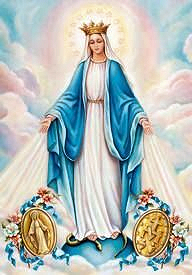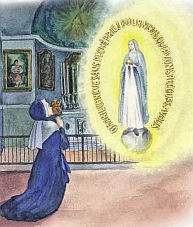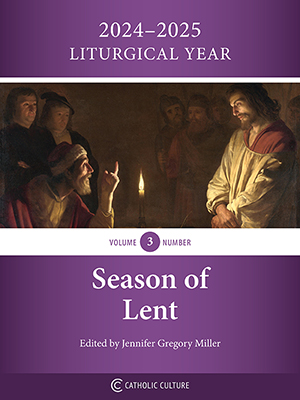Ordinary Time: November 27th
Monday of the Thirty-Fourth Week of Ordinary Time
Other Commemorations: Our Lady of the Miraculous Medal (Hist)
» Enjoy our Liturgical Seasons series of e-books!
What is man that You magnify him, And that You are concerned about him, That You examine him every morning And try him every moment? "Will You never turn Your gaze away from me, Nor let me alone until I swallow my spittle?" Have I sinned? What have I done to You, O watcher of men? Why have You set me as Your target, So that I am a burden to myself? "Why then do You not pardon my transgression And take away my iniquity? For now I will lie down in the dust; And You will seek me, but I will not be."
Our Lady of the Miraculous Medal
 In the year 1830, Our Lady appeared to St. Catherine Labouré, a Daughter of Charity in Paris, and told her that God had a mission for her. Standing upon a globe, the Virgin Mary held a golden ball which she seemed to offer to God, and on her fingers were rings with gems that emitted rays of light. She told St. Catherine, "These rays symbolize the graces I shed upon those who ask for them. The gems from which rays do not fall are the graces for which souls forget to ask." Afterward, the ball, symbolizing the world and each person, disappeared, and she held her hands outstretched in the manner of a loving mother, while rays of light continued to cascade upon the globe at her feet as she stood atop the serpent's head. Framing the image in an oval were the words, "O Mary, conceived without sin, pray for us who have recourse to thee." St. Catherine then saw an image of an M upon which was a cross. Underneath the M was Our Lord's heart crowned with thorns and Our Lady's heart pierced by a sword. Surrounding this image were 12 stars. The Blessed Virgin instructed St. Catherine to have a medal made of these images, and she promised many graces to all who wear it.
In the year 1830, Our Lady appeared to St. Catherine Labouré, a Daughter of Charity in Paris, and told her that God had a mission for her. Standing upon a globe, the Virgin Mary held a golden ball which she seemed to offer to God, and on her fingers were rings with gems that emitted rays of light. She told St. Catherine, "These rays symbolize the graces I shed upon those who ask for them. The gems from which rays do not fall are the graces for which souls forget to ask." Afterward, the ball, symbolizing the world and each person, disappeared, and she held her hands outstretched in the manner of a loving mother, while rays of light continued to cascade upon the globe at her feet as she stood atop the serpent's head. Framing the image in an oval were the words, "O Mary, conceived without sin, pray for us who have recourse to thee." St. Catherine then saw an image of an M upon which was a cross. Underneath the M was Our Lord's heart crowned with thorns and Our Lady's heart pierced by a sword. Surrounding this image were 12 stars. The Blessed Virgin instructed St. Catherine to have a medal made of these images, and she promised many graces to all who wear it.
Highlights and Things to Do:
- Read the inspiring story of the converson of Alphonse Ratisbonne. For a an entire book on the subject see The Conversion of Marie-Alphonse Ratisbonne by Baron Theodore de Bussieres.
- Read more about the Miraculous Medal at the Central Association of the Miraculous Medal and obtain a free Miraculous Medal.
- Learn more about the meaning of the medal at EWTN.
- Read the biography of St. Catherine Labouré by Fr. Joseph Dirvin, Saint Catherine Laboure of the Miraculous Medal.






